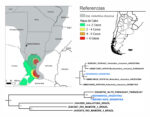Síndrome pulmonar por hantavirus asociado al Orthohantavirus Alto Paraguay en Argentina. Estudio del caso humano y potencial roedor reservorio
M. Laura Martin, Julia M. Brignone, Carina N. Sen, Jorge B. García, M. Carolina Cúdos, Verónica Andreu, Silvia Calatayud, Raúl E. González-IttigEl síndrome pulmonar por hantavirus (SPH) es una enfermedad viral aguda causada por miembros del género Orthohantavirus, familia Hantaviridae. En Argentina, se evidenció la circulación de diversos genotipos patógenos en diferentes roedores reservorios. Asimismo, se han identificado al menos cuatro genotipos no patógenos para humanos. En 2020 se confirmó el diagnóstico de un paciente con SPH, residente en la localidad de Colonia Montefiore (provincia de Santa Fe), sin antecedentes de viaje. El genotipo de orthohantavirus detectado en este paciente fue Alto Paraguay. Este genotipo había sido detectado anteriormente solo en Paraguay en roedores identificados como Holochilus chacarius, pero no en pacientes con SPH. Dado que en Argentina no existían registros sobre la circulación de este genotipo, se realizaron muestreos de la comunidad de roedores en los potenciales sitios de contagio del caso humano. Se capturaron 59 roedores, de los cuales se detectó un individuo de H. chacarius infectado con el genotipo Alto Paraguay. La comparación de las secuencias nucleotídicas de un fragmento de los segmentos genómicos S y M correspondientes al caso humano de SPH y al roedor H. chacarius presentaron un 100% de identidad. Estos resultados confirman la circulación de un nuevo genotipo de orthohantavirus patógeno en Argentina, y aportan evidencias de su potencial asociación con roedores de la especie H. chacarius, información de importancia para la toma de medidas de prevención.
Hantavirus pulmonary syndrome associated with the Orthohantavirus Alto Paraguay in Argentina. Human case study and potential rodent reservoir. Hantavirus pulmonary syndrome (HPS) is an acute viral illness caused by members of the genus Orthohantavirus, family Hantaviridae. In Argentina, there is evidence of the circulation of several pathogenic genotypes in diferent rodent reservoirs. In addition, at least four non-pathogenic genotypes for humans have been identified. In 2020, a patient inhabiting Colonia Montefiore (province of Santa Fe) without any travel history was diagnosed with HPS. The orthohantavirus genotype detected in the patient was Alto Paraguay. This genotype had previously been detected only in Paraguay in rodents identified as Holochilus chacarius, but not in patients with HPS. Since the circulation of this genotype was unknown in Argentina, we studied the rodent communities in rural areas near the site of the human infection case. Fifty-nine rodents were captured, and one specimen of H. chacarius proved to be infected with the Alto Paraguay genotype. The viral sequences of the rodent were compared with those of the patient, finding 100% nucleotide identity for the fragments of the S and M genomic segments. These results confirm the circulation of a new pathogenic genotype of orthohantavirus in Argentina, and provide evidence of its potential association with rodents of the species H. chacarius, important information for prevention measures.
